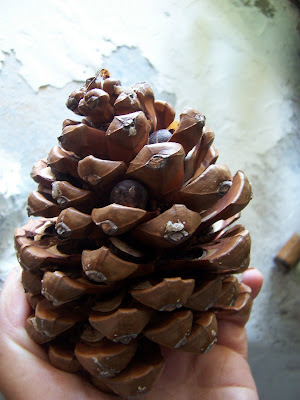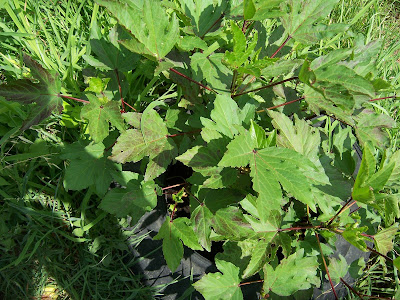We've just got back from a 3-night camping trip on our land to catch up with some work and I forgot to bring my camera, so no photos today. Summer has finally arrived with a vengeance and daytime temperatures have made work in anything but the early morning and late afternoon impossible. Currently my outside thermometer shows 35C in the shade!
So passing these hot lunchtime hours I thought I'll introduce you to 2 terms essential to understand the Italian mentality and I found occasion to use both in the last couple of days:
furbo and
brutta figura. The first is a desirable quality in Italians whilst the latter is to be avoided at all cost!
The word furbo, usually accompanied by an index finger tapped onto the side of the nose means cunning without the negative nuances it may have in English.
Cunning: artful, sly, deceptive, shrewd, astute, cute, on the ball and, indeed, arch. A word for for any praise and every prejudice. Cunning ... is a cunning word.
(quote from
Unseen Academicals by Terry Pratchett
In Italy everyone is
furbo. Any old way to get around paying your taxes or dodge cumbersome laws, rules and regulations. Who needs them anyway. When we got our beagle puppy (or Beagol as the Italians insist on pronouncing the breed) everyone said:
"Sono furbi!", meaning they are cunning dogs, which have a way of finding their own thing and are therefore difficult to train.
While we were staying on our land we found a perfect example of his cunningness. There is no physical barrier between our plot and the neighbours except the narrow path down, which serves as access to both our properties. The neighbour, who is not the most sociable person and mainly talks to himself, comes to his plot every single day of the year, come rain or shine, if for nothing else to put some food out for the local stay cat population. So on more than one occasion he had to chase Eddie out of his land, so he wouldn't steal the cat food. On many other occasions I had to drag him out of there by the scruff of his neck while telling him off in a stern voice.
By now he knows exactly it's a no-go area. Every time he as much as moves in the direction of the cat food terrace he gets a stern word from either of us, which usually does the trick. So what does Eddie do? He either waits until both of us have turned our back before sneeking up there, or, even more
furbo, innocently wanders off in the opposite direction, whistling obliviously, just to find a longer, but for us undetectable route to the same goal. Only after not seeing him for a while and us wondering where he'd got to, we'd start looking for him and invariably finding him... at the neighbour's cat feeding station.
The neighbour has even resorted to putting the food on top of some old rabbit cages out of small dog's reach. But Eddie just found a way of going to the terrace above and then kamikaziing down on top of the cages.
That's furbo!
As for
la brutta figura, that's what all Italians try and avoid and of course I'm owning up to one now. It literally means ugly figure but can best be translated as loosing face in front of your peers. No Italian likes to admit they are wrong about anything and they are all experts on everything. So a really bad brutta figura is when you trip up in your actual field of expertise!
For example if you would serve me as a wine expert and nasty Vin de Plonk and I would declare it to be a top notch claret, that would be a
brutta figura. But my more recent
brutta figura has come from another chosen expert field, that of
wild food gathering. As my regular followers know I talk about it a lot and even do a regular feature of it.
Now in recent months amongst fellow garden bloggers, amaranth has been a bit of a buzz word. The ancient food of the Incas, which has been cultivated in ancient times because of it's nutrtious values both of the leaves and the seeds. I first heard of it from
Kate in Australia I think. Then I heard my mate
Mr.H and others mentioning it. Finally I got some seeds from
GetSoiled all the way from sunny Florida.
I sowed the seeds and nothing happened, zilch, zero, niente. I thought, well that's it then, it might grow in Tasmania, Idaho and Florida, but it clearly doesn't like Italy. Shame, because I also read that it makes some good companion planting, helping to break up heavy soil, which I've got!
It started dawning on me when
Ayak posted some photos of some weeds she found in her garden and Mr H commented that one of them could be pigweed, a variety of amaranth. Now erm... whilst weeding around my sweetcorn I discovered something very much like it. In fact I remember it going to flower in previous years and another look around internet land pretty much confirmed it: I've got at least 2 different varieties of amaranth growing wild on my land!
Whilst still camping on the land I actually added some to a potato, leek, courgette and bean bake I made on the BBQ and we've survived the experiment! (Nothing goes over the taste test: if it doesn't make you very ill, it's edible!).
Now unfortunately, as I said above I didn't have my camera with me, but will post some pics soon.



 If you are unlucky your shell will be empty, as happens with at least 50%
If you are unlucky your shell will be empty, as happens with at least 50%
 The shell is extremely tough so it took me the best part of an hour to just get a small handful. It explains why they are so expensive when you buy them in a shop, however, fresh like this they actually taste of pine resin and are really aromatic, unlike most shop bought varieties which only seem to add texture to your pesto.
The shell is extremely tough so it took me the best part of an hour to just get a small handful. It explains why they are so expensive when you buy them in a shop, however, fresh like this they actually taste of pine resin and are really aromatic, unlike most shop bought varieties which only seem to add texture to your pesto.



























